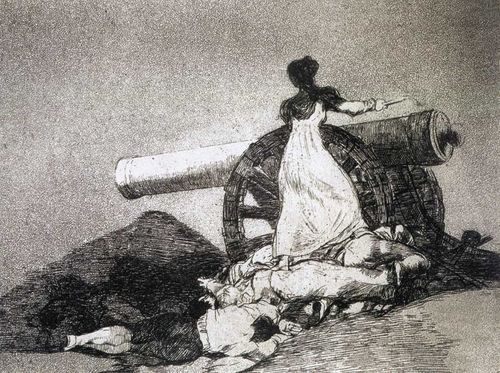This must not repeat
An exhibit of Francisco Goya’s prints “The Disasters of War” opens in Bohdan and Varvara Khanenko Museum of Art
The mercilessness and drama of these pictures cannot leave anyone indifferent. Today, 200 years after they were created, few if any visitors look at the works of the Spanish master as at “pure art,” without drawing parallels with current political situation, when the Crimea has been taken, and Russian forces are concentrated close to Ukrainian border.
The world-famous 82 prints created by Francisco Goya in 1810s-1820s were banned by the royal power in the artist’s lifetime for sharp criticism. “I have seen this” is a short and truthful commentary of the master to the series of prints “The Disasters of War,” which urge the humankind not to repeat the catastrophe of pointless mutual destruction.
“The exhibit ‘The Disasters of War’ is an anti-war manifesto of our museum,” said assistant director-general on civic and scientific work Kateryna CHUIEVA. “Aggression can never be justified. The exposition of Francisco Goya’s prints draws a direct historical parallel: in 1808 a powerful wave of revolts took place in Spain. Napoleon I used this to bring his army into the country, weakened by internal clashes. We know how the story ended: Spaniards got rid of the French, but the king of Spain Ferdinand VII banned to publish the series, and only in 1863 the Academy of Fine Arts in Madrid published the complete series for the first time, under the title ‘The Horrors of War,’ and later became known to the public as ‘The Disasters of War.’”
Goya’s works presented at the exhibit are Ukraine’s only complete set of engravings, printed from the original plates. The numbers and inscriptions on the plates, including the orthographic mistakes made by Goya, were copied from Juan Agustin Cean Bermudez’s album and engraved on copper plates, which were later used to make the prints.
“The entire collection of the etchings came to the museum several months prior to the occupation of Kyiv in April 1941,” Chuieva reminded, “According to the documents, it was bought from the well-known Kyiv artist M. Sharonov. The series has not been shown very frequently while being stored in the museum, that is why today’s exhibit is especially valuable for the audience.”
It is known that the Academy reprinted the plates several times – last time in 1937. The Khanenko Museum owns the prints of the fourth edition of 1906 – according to experts it is very valuable, not only due to its artistic merits, but also the high quality of paper.
It is important to understand the role of Goya as the first court artist, who according to his rank was supposed to paint portraits of crowned persons, Spanish and French nobility. Performing his duties, he acutely experienced what was going on with the people: the war had a powerful impact on his world perception, but he had to splash this out in creative work, which he deliberately addressed to a narrow circle of close friends. By and large, the author created “The Disasters of War” for himself, because their black-and-white minimalism and small seize turned out to be the most appropriate tools to manuscript the war, which was not expected to be approved by the highest echelons of power.
The curator of the exhibit Olena Shostak said that “The Disasters of War” series consists of three parts. The prints can be viewed according to thematic principles: Goya starts his narration from the heroic defense of Saragossa, a witness of which he was. On the next plates the artist moves to plots dedicated to the sad fate of women who turned out to be defenseless before the massacre. Later the master turns to the guerilla war between Spanish peasants and French conquerors. The last pieces in the series are distinguished due to their deep symbolic meaning: these are generalized philosophical reflections about the destiny of the country, torn into pieces, the nonsensical aggression of people forced to wage war against one another.
Interestingly, it was not Goya who invented the title “The Disasters of War,” which is now known to the world. There is a different title the artist wrote on the album he presented to his close friend: “Fatal consequences of Spain’s bloody war with Bonaparte, and other emphatic caprices” – this long title and the master’s commentaries to the prints is the only documentary evidence of Francisco Goya himself. The author himself is in this severe laconism: his grave psychological condition, the progressing disease, and deafness made the exposing-critical character of the paintings significantly more acute.
The value of the series is in its “living nerve”: the defiant and bold refusal from classical pompous depiction of the war with unnaturally idealized, chimerical-dramatized images of the “heroes of fatherland.” Francisco Goya depicted the image of human fear, despair, and fury – loss of all moral norms of a person who crossed the line. No other artist would have been able to show his hatred to violence in the way the author of virtuoso “Capriccios” did.
The exhibit “The Disasters of War” will be open till May 25.






